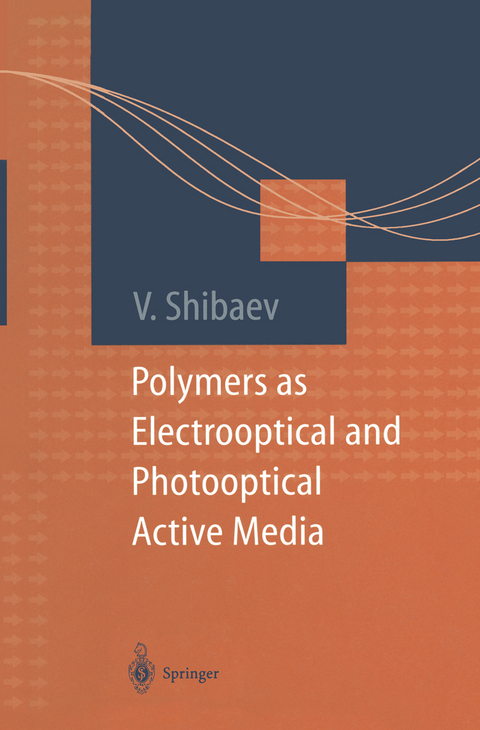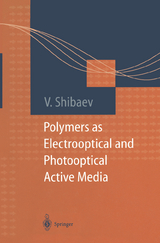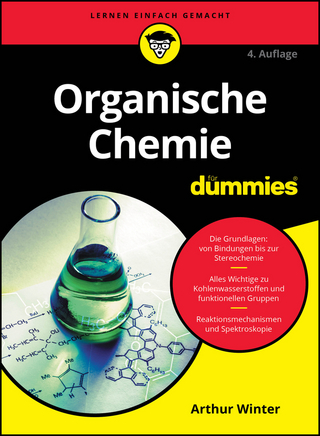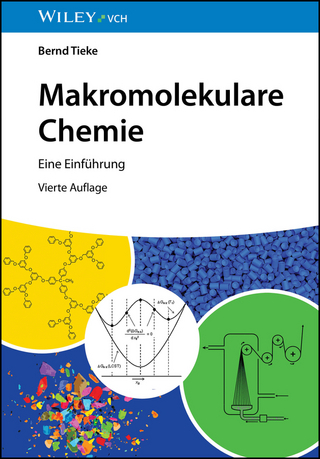Polymers as Electrooptical and Photooptical Active Media
Springer Berlin (Verlag)
978-3-540-59486-4 (ISBN)
- Keine Verlagsinformationen verfügbar
- Artikel merken
1 Photochemical Hole Burning and Photooptical Properties of Doped Dye Molecules in Linear Polymers.- 1.1 Introduction.- 1.2 Photochemical Hole Burning of Dye/Polymer Systems.- 1.2.1 Hole Burning Mechanisms.- 1.2.2 High-Temperature Hole Burning and Thermal Stability of Holes.- 1.2.3 Photon-Gated Hole Burning Systems.- 1.2.4 Required Properties for PHB Materials for Practical Application.- 1.2.5 Electric-Field Readout and Holographic Detection.- 1.2.6 Single Molecule Spectroscopy.- 1.3 Photon Echo of Dye/Polymer Systems.- 1.3.1 Principle of Photon Echo.- 1.3.2 Kinds of Photon Echo Materials.- 1.4 Photoinduced Refractive Index Change and Birefringence of Dye/Polymer Systems.- 1.4.1 Photooptical Effects Induced by Photochromic Reactions.- 1.4.2 Optical Phase Conjugation Using Saturable Absorber Dyes.- 1.4.3 Photorefractive Effect of Photoconducting Electro-Optic Polymers.- 1.5 References.- 2 Comb-Shaped Polymers with Mesogenic Side Groups as Electro- and Photooptical Active Media.- 2.1 Introduction.- 2.2 Specific Features of the Molecular Structure of Functionalized Comb-Shaped Liquid-Crystalline Polymers.- 2.3 Comb-Shaped Dye-Containing Polymers with Mesogenic Side Groups.- 2.4 Electrooptical Behavior of Liquid-Crystalline Compounds.- 2.4.1 Low-Molar-Mass Liquid Crystals in Electric Fields (Field Effects).- 2.4.2 Electrooptical Effects in Comb-Shaped Liquid-Crystalline Polymers.- 2.5 Thermooptical Recording of Information on Films of Comb-Shaped Liquid-Crystalline Polymers.- 2.6 Photooptical Effects in Comb-Shaped Polymers.- 2.6.1 General Consideration.- 2.6.2 Origin of Photoinduced Optical Anisotropy.- 2.6.3 Kinetic Regularities of Photoinduced Processes.- 2.7 Summary and Outlook.- 2.8 References.- 3 Cyclic Liquid-Crystalline Siloxanes as Optical Recording Materials.- 3.1 Introduction.- 3.2 Cyclic Liquid-Crystalline Siloxanes.- 3.2.1 General Synthetic Aspects.- 3.2.2 Synthesis.- 3.2.2.1 Synthesis of Siloxanes.- 3.2.2.2 Connection of Mesogens to the Siloxane by Hydrosilylation.- 3.2.3 Synthesis of Crosslinkable Materials.- 3.3 Optical Recording with Cyclic Liquid-Crystalline Siloxanes.- 3.3.1 Permanent Recording.- 3.3.1.1 Photopolymerization.- 3.3.1.2 Photobleaching.- 3.3.1.2.1 In the Presence of Benzophenone.- 3.3.1.2.2 In the Presence of Carbon Black.- 3.3.2 Reversible Recording.- 3.3.2.1 Reversible Thermal Recording.- 3.3.2.2 Recording by cis-trans Isomerization.- 3.3.2.2.1 Materials.- 3.3.2.2.2 Determination of Holographic Material Parameters.- 3.3.2.2.3 Writing with Polarized Light.- 3.3.2.2.4 Writing with Unpolarized Light.- 3.3.2.2.5 Erasing.- 3.3.2.2.6 Sensitivity.- 3.3.2.2.7 Resolution.- 3.3.2.3 Recording of SHG-Patterns.- 3.4 References.- 4 Photoregulation of Liquid Crystal Alignment by Photochromic Molecules and Polymeric Thin Films.- 4.1 Introduction.- 4.2 Alignment Regulation by Surface-Modified Silica.- 4.2.1 Surface Modification of Silica and Cell Fabrication.- 4.2.2 Factors Affecting Alignment Regulation.- 4.2.2.1 Structure of Azobenzene Derivatives.- 4.2.2.2 Photochromic Units Other than Azobenzene Derivatives.- 4.2.2.3 Surface Photochromic Reaction and Alignment Alteration.- 4.2.2.4 Properties of Photoresponsive Liquid Crystal Cells.- 4.3 Alignment Regulation by Polymer Thin Films.- 4.3.1 Surface-Modified Polymer Thin Films.- 4.3.2 Spin-Coated Polymer Thin Films.- 4.3.3 Polymeric Langmuir-Blodgett (LB) Membranes.- 4.4 Surface-Assisted Azimuthal Alignment Regulation.- 4.4.1 Photoinduced Molecular Reorientation.- 4.4.2 Polymer Thin Films Doped with Dichroic Dyes.- 4.4.3 Photocrosslinkable Polymers.- 4.4.4 Azobenzene Molecular Layers Exposed to Polarized UV Light.- 4.4.5 Surface Azobenzenes Exposed to Polarized Visible Light.- 4.4.6 Spiropyran as a Command Molecule.- 4.4.7 Photochromic Polymer Layer.- 4.5 Future Aspects.- 4.6 References.- 5 Electric Field Poling of Nonlinear Optical Side Chain Polymers.- 5.1 Introduction: Context and Scope.- 5.2 The Electrooptical Effect in Optically Nonlinear Materials.- 5.2.1 Organic Materials.- 5.2.2 Poled Polymers.- 5.3 Theoretical Models for the Calculation of Order Parameters..- 5.3.1 General Consideration.- 5.3.2 Isotropic Model Versus Ising Model:Enhancement of Polar Order by Axial Order.- 5.3.3 Liquid-Crystalline Axial Order.- 5.3.4 Singer-Kuzyk-Sohn (SKS) Model for Mixed Rod Systems.- 5.3.5 Maier-Saupe-van der Vorst-Picken (MSVP) Model for Single Rod Systems.- 5.3.6 Influence from Dipole-Dipole Interaction.- 5.3.7 Ising Models Including Dipolar Interaction.- 5.3.8 Introduction of Pair Formation into MSVP Model.- 5.3.9 Theoretical Model of Wang (1993) Including Pair Correlation.- 5.3.10 Model of Wu (1991) to Describe Transient Phenomena.- 5.3.11 Other Models.- 5.4 Measurements of the Electrooptical Effect in Polymer Samples.- 5.4.1 Measurements During Poling.- 5.4.2 Electro-Optic Measuring Methods.- 5.5 Comparison of Experimental Results with Theory.- 5.5.1 General Consideration.- 5.5.2 Dilute Liquid-Crystalline Systems.- 5.5.3 Concentrated Isotropic Systems.- 5.5.4 Concentrated Liquid-Crystalline Systems.- 5.5.5 Other Relevant Experiments.- 5.6 Summary.- 5.7 References.
| Erscheint lt. Verlag | 30.7.1996 |
|---|---|
| Reihe/Serie | Macromolecular Systems - Materials Approach |
| Zusatzinfo | XVIII, 211 p. |
| Verlagsort | Berlin |
| Sprache | englisch |
| Maße | 155 x 235 mm |
| Gewicht | 464 g |
| Themenwelt | Naturwissenschaften ► Chemie ► Organische Chemie |
| Naturwissenschaften ► Chemie ► Physikalische Chemie | |
| Naturwissenschaften ► Physik / Astronomie ► Festkörperphysik | |
| Naturwissenschaften ► Physik / Astronomie ► Thermodynamik | |
| Technik ► Maschinenbau | |
| Schlagworte | Birefringence • Compound • Electrooptic • Elektrooptik • HC/Chemie/Organische Chemie • Macromoleculs • Makromoleküle • Photochemie • Photooptic • Photooptik • Polymer • Polymere • Polymers • Refractive index |
| ISBN-10 | 3-540-59486-8 / 3540594868 |
| ISBN-13 | 978-3-540-59486-4 / 9783540594864 |
| Zustand | Neuware |
| Informationen gemäß Produktsicherheitsverordnung (GPSR) | |
| Haben Sie eine Frage zum Produkt? |
aus dem Bereich




